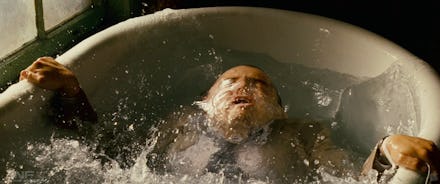Scientists Have Discovered a Way For You to Take Total Control of Your Dreams

The news: In the 2010 film Inception, it's bad news to realize you're dreaming.
When Leonardo DiCaprio's character reveals to Ellen Page that their outdoor café chat isn't really happening, for instance, the world unravels: Page panics, her coffee starts vibrating and everything around them explodes.
But in real life, "lucid dreaming" — or realizing you're in a dream while it's happening — is a valuable and coveted state. And in a revolutionary new study, scientists may have discovered exactly how to make it happen.
Really. The results were published in Nature Neuroscience this weekend, and they're pretty fascinating. Twenty-seven healthy adult volunteers spent multiple nights sleeping in a lab in Germany, where they eventually entered the REM (rapid eye movement) stage of sleep. About two minutes in, the researchers applied a weak 30-second electrical current directly to the frontal lobes of some of the patients. The others received a "sham current with no electricity."
Image Credit: Collective Evolution
The outcome was telling: For the subjects who received electricity, particularly at an output of 40 Hertz, lucid dreaming was reported 77% of the time. Another 58% reported lucidity when exposed to 25 Hertz, while lucid dreaming was never reported by any of the subjects who received zero electricity.
As none of the volunteers had a history of such dreams, the results, though self-reported, seem reliable. In addition, none were aware what type of stimulation they'd be receiving, nor was the electrical current strong enough to wake them on its own.
According to a 2009 study, the 30-40 Hertz range is a sweet spot for lucidity. This rate matches the brain waves typically measured during unprompted lucid dreams, which represent much higher brain function than a normal REM cycle.
Why this is important: Vox reports that these findings constitute a "major contribution to consciousness research." Not only are they conceptually intriguing, they may represent possible ways to treat mental health problems, like the "recurring nightmares" that accompany post-traumatic stress disorder (PTSD).
Gutenberg University philosopher Thomas Metzinger also points out that the transition from non-lucid to lucid dreaming is similar to "snapping back to attention after daydreaming," so the study could provide insight into waking life as well. Additionally, electricity has become increasingly common in brain treatments in general: The FDA recently approved "an electrical brain implant that treats tremors associated with Parkinson's disease."
Of course, this method is still in its early stages. Needless to say, don't try this at home. But all told, the possibilities are certainly exciting and may constitute an entirely new way of studying the brain and the physiological impact of dreams.
Christopher Nolan would be proud.